
In the 1990’s our knowledge about the universe increased. The latest research became accessible for more and more people, and the launch of the 1990 Hubble telescope was an instant gravitational pull for Arje Griegst.
It was possible to get an insight into the existing mysteries and to what may have happened at its birth – during and just after the Big Bang. From all the crowds and diversity there is here on Earth, Arje turned his gaze towards the endless celestial sky.
Arje Griegst’s rings writhe as if they have been exposed to these remarkable forces. The gold twinkles like stars in the firmament. The stones brood in the mass of light, just like they can do in Nature.
Arje, who was already interested in the Cosmos in his youth, now returned to the nebulae of the universe, galaxies and supernovas. To a world in a permanent state of transformation, exposed to dynamic forces such as ultraviolet radiation, explosions, solar wind, collapse, dark matter, stardust and black holes.
Arje and his wife, Irene, read everything they could find about outer space, they discussed new scientific discoveries and allowed their eyes to be opened with fascinated awe to all the fantastic pictures.
Few things are more mysterious than the universe, and for an artist like Arje, whose entire body of work is about strange, mythical kingdoms, its images of glittering galaxies and nebulas – like the Pillars of Creation rising from interstellar gas and dust like some divine primordial life force – send Griegst on a cosmic journey resulting in a series of celestial rings.
Crafted in cire perdue, they look as if the gold has been bombarded by showers of meteorites or like distant asteroids, luring us with craters filled with raw diamonds and cabochon cut sapphires and crates of precious stones and gems. One of them was called Cosmos, depicting the starry sky’s vibrant shimmer.
